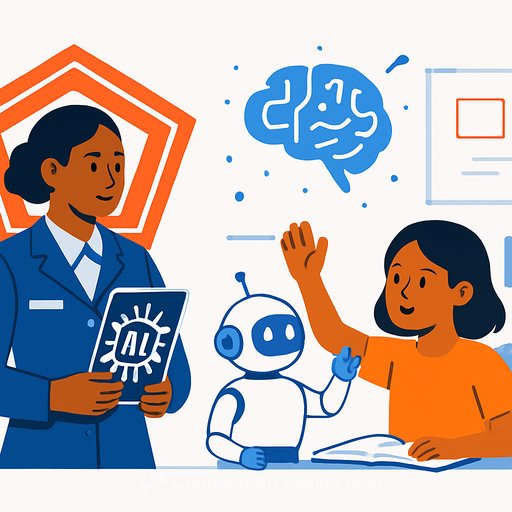What the U.S. Air Force Wants to Know About AI in K-12 - and Why Educators Should Care
U.S. Air Force Lt. Col. Hillery Anderson arrived at Brown University's Watson Institute as a visiting scholar and national defense fellow after serving as an intelligence officer at the Pentagon. Her mission here is simple and timely: study how artificial intelligence will be used in children's education and what that means for learning and development.
Why does the Air Force care? Because every future recruit comes from our classrooms. If AI changes how students learn and what they can do, the force they join changes, too.
Who is Lt. Col. Hillery Anderson?
Anderson grew up in Southern California, the daughter of Panamanian immigrants, not far from March Air Force Base. With two high-achieving older siblings, she set a high bar for herself and followed a public policy track at Syracuse University's Maxwell School.
She joined Air Force ROTC in college, was selected for the intelligence career field, and trained at Goodfellow Air Force Base. Her career spans assignments at Beale AFB, deployments supporting operations in Afghanistan, Iraq, and Africa, and staff service at Indo-Pacific Command and the Pentagon. Along the way, she earned advanced degrees in public policy, operational art and science, and military strategy.
Encouraged by her commander, she pursued a competitive military fellowship. She chose Brown for its open, cross-disciplinary approach - a good fit for a topic as broad as AI in education.
The two questions schools should answer now
Anderson is focusing on two blunt questions educators will recognize:
- How will AI change the way children learn - attention, problem-solving, writing, collaboration - over time?
- What level of AI proficiency should graduates have by the time they enter work, college, or the military?
Her view: both matter. The first shapes pedagogy. The second shapes standards, assessments, and workforce readiness.
Policy tailwinds you should know
Federal attention is growing. Anderson cited a 2025 executive order emphasizing AI literacy, educator training, and early exposure to AI concepts to build an AI-ready workforce. The message to K-12 is clear: AI education isn't optional - it's becoming baseline.
She also draws a parallel to the space race. Competition with China on AI echoes the Sputnik moment, but with a twist: AI is less visible, harder to measure, and, as she puts it, "kind of a black hole." That's exactly why clear benchmarks and thoughtful classroom use are needed.
Practical steps for district and school leaders
- Set AI literacy goals by grade band. Define what "can use AI well" means for your community.
- Adopt classroom norms for AI use. Spell out when AI is allowed, how it's cited, and where it's off-limits.
- Protect privacy. Vet tools for data use, age requirements, and compliance with FERPA and COPPA. Keep local data out by default unless you have written agreements.
- Teach verification as a habit. Require source checks, bias checks, and error-spotting in any AI-assisted work.
- Invest in teacher time. Provide PD, model lessons, and co-planning. Start with volunteers, then scale.
- Pilot with purpose. Pick 2-3 high-impact use cases (IEP drafting support, formative feedback, tutoring), collect evidence, adjust policy, and expand.
- Plan for equity. Address access, accommodations, multilingual use, and offline options so AI doesn't widen gaps.
Sample AI proficiency benchmarks
- Upper elementary: Knows what AI is and isn't, uses kid-safe tools with rules, spots when information might be made up, asks clear questions.
- Middle school: Writes simple prompts, summarizes and compares sources, labels AI assistance in work, identifies bias or missing context.
- High school: Iterates prompts with constraints and roles, critiques model limits, cites AI contributions, uses basic data tasks (tables, charts), experiments with no-code automations or simple coding where appropriate.
Keep it simple: clarity, verification, and ethical use come first. Fancy tools can wait.
Instructional guardrails that actually help
- Assessment: Mix in-class creation with AI-assisted drafts. Ask for process artifacts (prompts, iterations, reflections) to make thinking visible.
- Academic integrity: Teach citation of AI assistance. Use oral checks and quick writes to verify individual understanding.
- Special education and multilingual learning: Use AI for plain-language supports, reading companions, and idea scaffolds - always with human review.
- Career connections: Map AI tasks to local employers, community colleges, and service pathways so students see the why.
Why this matters for the Air Force - and your graduates
Anderson's point is practical: tomorrow's recruits will arrive with different habits of mind. If students learn with AI from an early age, the Air Force needs to know what they can do on day one - and so do you. Defining expectations now helps everyone: students, teachers, families, colleges, and employers.
Resources to move fast without breaking trust
- U.S. Office of Educational Technology: AI Guidance and resources
- Complete AI Training: Courses by job to upskill educators
The bottom line
AI will sit beside your students - and your teachers - whether you plan for it or not. Follow Anderson's lead: set clear benchmarks, teach verification, protect privacy, and build staff capacity. Do that, and you'll graduate students who can use AI with judgment, not just curiosity.
Your membership also unlocks:






